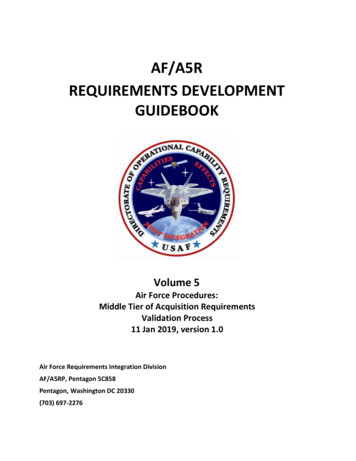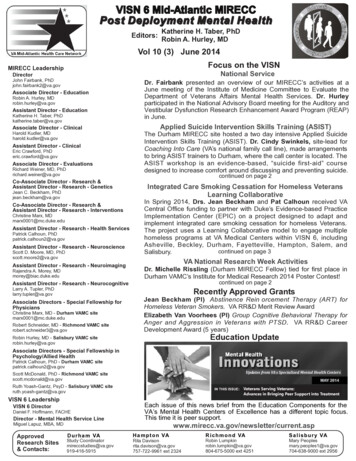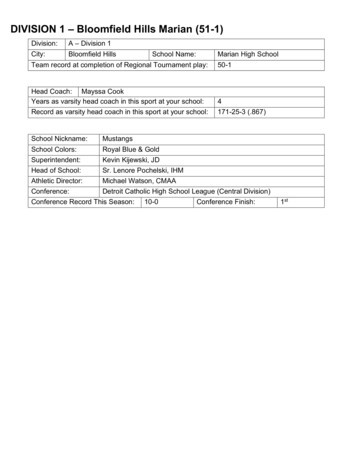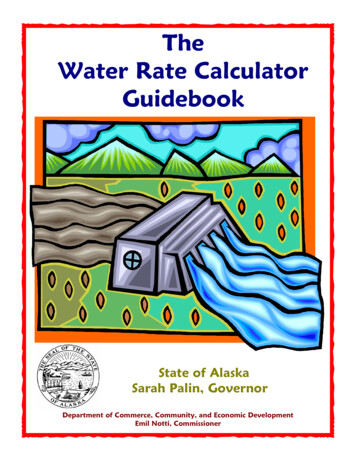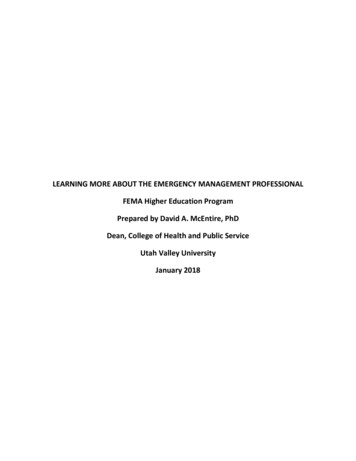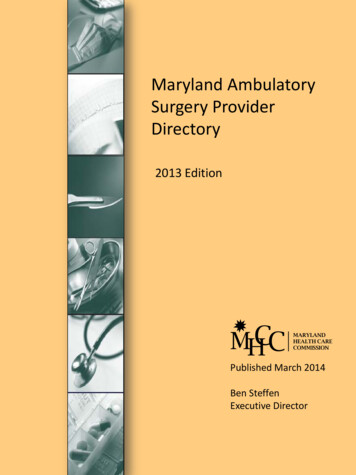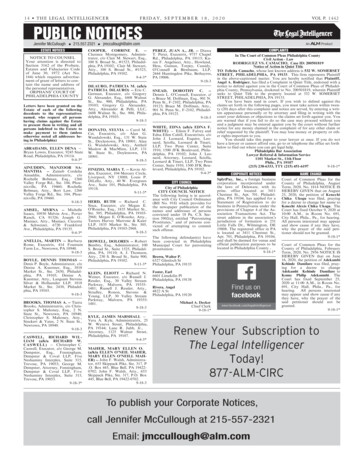
Transcription
National Weather ServiceEmergency Manager GuidebookNational Weather Service Sioux Falls SD, 26 Weather Lane, Sioux Falls, SD 57104, 605-330-4247Table of ContentsPage 1: About the National Weather ServicePage 18: Fire WeatherPage 2: National Weather Service WebsitePage 19: DroughtPage 3: Hourly Weather ForecastPage 20: ClimatePage 4: Forecast Points WebsitePage 21: NWS National CentersPage 5: National Weather Service MobilePage 22: NWS Summer Headline DefinitionsPage 6: Social MediaPage 23: NWS Winter Headline DefinitionsPage 7: NOAA All Hazards Weather RadioPage 24: NWS Other Headline DefinitionsPage 8: NWSChat and Interactive NWS (iNWS)Page 25: Severe Weather Awareness TrainingPage 9: Decision Support PacketsPage 26: StormReady and Weather Ready NationPage 10: Wireless Emergency Alerts (WEA) andNon-Weather Emergency MessagesPage 11: Special Event SupportPage 12: Unplanned Decision SupportAmbassadorsPage 27: Tri-State Emergency ManagementAssociationPage 28: Important Contacts and WebsitesPage 13: Damage SurveysPage 14: Winter Weather PagePage 15: Probabilistic Snowfall PagePage 16: Probabilistic Snowfall Page (Continued)Page 17: Advanced Hydrologic Prediction Service(AHPS)Last Updated 11/4/21
National Weather ServiceEmergency Manager GuidebookThe National Weather Service (NWS) considers emergency managers “core partners.”Among all the people and organizations we serve on a daily basis, meeting your needs isour top priority. You provide a critical link between us and your local communities. You willlikely interact with the NWS during active hazardous weather events as well as moretranquil times.This guidebook is designed to help you better understand the products and servicesoffered by the NWS in Sioux Falls, SD. All questions can be directed to Peter Rogers,Warning Coordination Meteorologist, at 605-330-4247 or peter.rogers@noaa.gov.About the National Weather ServiceThe NWS is a federal agency under the Department of Commerce (DOC) and the NationalOceanic and Atmospheric Administration (NOAA). Our mission is the protection of life andproperty and the enhancement of the national economy.There are 122 local forecastoffices across the nation. Theoffice located in Sioux Fallsissues forecasts, watches,warnings, and advisories for 45counties across southeast SouthDakota, southwest Minnesota,northwest Iowa, and extremenortheast Nebraska. We have 24staff members and are open24/7/365.Back to Top1
National Weather Service Websitewww.weather.gov/siouxfallsAll forecast, watch, warning, and advisory information is available on our website.Numerous sub-menus also provide current conditions, radar, satellite, river and floodinformation, climate summaries, and storm reports just to name a few. If you are unfamiliarwith our website, we encourage you to take some time to check it out!48132Expert Tip:Short video tutorials on howto navigate our website canbe found here.51.2.3.4.6Current conditions and forecastWatches, warnings, and advisoriesPoint and Click Forecast MapProduct LinksBack to Top75.6.7.8.Weather StoryWeather MapRadarDecision Support Packet (see pg. 9)2
Hourly Weather ForecastThe Hourly Weather Forecast (graph) provides you an hour-by-hour breakdown of criticalweather parameters (i.e. temperature, wind, precipitation potential) for a user definedlocation. These graphs are updated every time the forecast is adjusted and may proveuseful in your decision-making-process.12Step 1: Go to the NWS SiouxFalls website and click near yourlocation on the forecast map.3Step 2: Scroll down the page and click on theHourly Weather Forecast graphic on the righthand side under Additional Resources.Step 3: Customizeyour graph by pickingthe Weather Elementsyou wish to view andclick Submit. You canalso add fire weatherparameters orprobabilistic forecastinformation.Click anywhere on thegraph to view a tabularversion of the data.Bookmark this page forfuture access.Back to Top3
Forecast Points Websitewww.weather.gov/forecastpointsThe NWS also offers point-specific hourly forecast information at a new Forecast Pointswebsite. Information on this website is provided in an easy-to-read tabular or graphicalformat and can be customized.Enter your location or latitude/longitude in the search bar at the top of the page.Seven-day forecast information is provided in a tabular format. The Weekly Summaryprovides a breakdown of maximum and minimum values over a 24-hour period and theHourly Table provides a breakdown of hourly forecast values. You can also see if yourlocation is highlighted in a Severe Thunderstorm or Excessive Rainfall risk (not shown).Scroll to the bottom of thepage to view the hourlyforecast in a graphicalformat. Click on theConfigure Plot Order orConfigure Plot Lookbuttons to customize thegraphs (not shown). Byhovering your mouse overan individual graph, youcan see specific numericalforecast and timinginformation.Back to Top4
National Weather Service Mobilewww.mobile.weather.govThe NWS does not operate a mobile app. Numerous third-party weather apps areavailable on various mobile platforms. We encourage you to find one that works for you.Otherwise, you can point your mobile browser (e.g. Chrome, Safari) to mobile.weather.govfor a mobile friendly version of the main NWS website.mobile.weather.govEnter your zip, city, or place and click Go! for current conditions, forecast, and warninginformation. Then, place an icon (bookmark) on your home screen for easy future access.Back to Top5
Social MediaThe NWS is very active on social media, specifically Facebook, Twitter, and YouTube.Every shift, we have one forecaster dedicated to posting to and monitoring our accounts.Search for NWS Sioux Falls and “Like”Weather stories, forecast graphics, andpreparedness information are most oftenshared on Facebook. The platform alsoprovides a great way for partners and thegeneral public to share real time severeweather reports and pictures.Search for @NWSSiouxFallsand “Follow”Quick-changing real-time information ismost often shared on Twitter. As withFacebook, the platform provides a way forpartners and the general public to interactwith forecast staff.Search for NWS Sioux Fallsand “Subscribe”Recordings of weather briefings andeducation-based videos are posted toYouTube.Back to Top6
NOAA All Hazards Weather Radiowww.weather.gov/nwrThe NWS in Sioux Falls maintains 13 radio transmitters, providing continuous livebroadcasts of current conditions, forecasts, watches, warnings, and advisories.Specially-built radios can be tuned to one of seven frequencies (listed below) to monitorthe broadcast. In addition, radios enabled with Specific Area Message Encoding (SAME)technology can be programed to automatically alert for warning, watch, or other nonweather emergencies for user-defined counties.MinnesotaSouth 500162.525162.550To learn more about radio receivers, click here.Click here to view coverage maps.To look-up county frequencies and SAME codes, click here.Back to Top7
NWSChatnwschat.weather.govNWSChat is a desktop-based Instant Messaging program utilized by NWS forecasters toshare critical warning decision expertise and other types of significant weatherinformation. It also provides a forum for partner questions and direct interaction withforecasters. NWSChat is available to emergency managers, government partners, and themedia. It is NOT open to the general public.To request a NWSChat account, click here.For information on supported chat clients, installation, and configuration, click here.NWSChat can be accessed here without the installation of a chat client.Interactive NWS (iNWS)inws.ncep.noaa.govInteractive NWS (iNWS) is a mobile alerting system that allows you to receive customizedtext messages and/or email alerts for NWS products important to you. As with NWSChat,iNWS is only available to emergency managers, government partners, and the media. Toregister for iNWS, click the Register button in the upper right-hand-corner of this site.Back to Top8
Decision Support PacketsPrior to and during high-impact weather events, the NWS will issue twice-a-day(approximately 2-5 AM and 2-5 PM) Decision Support Packets in the form of a shareablePDF. You will automatically receive these reports in your email inbox. They are also sentto school superintendents and state-level transportation officials, but you are encouragedto set up automatic forward filters to notify other local officials or interested organizations.When in effect, the Decision Support Packet can also be accessed from our website,highlighted by the bright yellow box in the upper right-hand-corner or at this direct link.To fill the 12-hour information gap between Decision Support Packets, we will oftentimessend brief Status Update emails to highlight any changes to the current conditions orforecast. You can also monitor our website or social media for the latest information.MorningFull PacketAfternoonFull PacketMid-Morning UpdateBack to TopEvening Update9
Wireless Emergency Alerts (WEA)The NWS partners with the Federal Communications Commission (FCC) and the FederalEmergency Management Agency (FEMA) to send life-saving messages to mobile devicesusing Wireless Emergency Alerts (WEA). WEA is a public safety system that allowscustomers who own compatible mobile devices to receive geographically targeted, textlike messages alerting them of imminent threats to safety in their area.Weather alerts transmitted via WEA:Tornado Warnings (TOR)Severe Thunderstorm Warnings* (SVR)Flash Flood Warnings** (FFW)Snow Squall Warnings (SQW)*Only SVRs with 2.75” hail or larger and/or 80 mph orgreater wind will transmit over WEA.**Only FFWs with CONSIDERABLE or CATASTROPHICdamage tags will transmit over WEA.WEA reception is dependent on the mobile device and the service provider. WEA 2.0allows for 360 character messages and Spanish language capabilities. WEA 3.0 addscarrier geotargeting within 0.1 miles of the warning polygon.Non-Weather Emergency MessagesNon-weather emergency messages (NWEMs) include (but are not limited to) CivilEmergency Messages, 911 Telephone Outage Emergency Messages, and EvacuationMessages. In the event you do not have the capacity to send NWEMs to FEMA’sIntegrated Public Alert Warning System (IPAWS), the NWS can transmit the message onyour behalf. Contact the NWS office in Sioux Falls for more information.NOTE: The NWS is not authorized to transmit NWEMs to IPAWS and IPAWS is the soleconduit to WEA. Therefore, NWEMs will not activate WEA and will only be transmittedacross the NOAA All Hazards Weather Radio and the Emergency Alert System (EAS).Back to Top10
Special Event SupportThe NWS can provide Impact-BasedDecision Support for planned specialevents, such as outdoor concerts, countyfairs, and regional sporting events. Supportwill differ from event to event, but caninclude onsite deployments to emergencyoperations centers or remote assistance inthe form of phone calls, online webinars,and email briefings. An Active WeatherWatch will be conducted for ALL supportedevents, meaning our office will give you aheads-up call if a hazard meeting predetermined thresholds is expected to impactyour event.PixabayA formal request is REQUIRED to receive this level of support. The request must be madeby you or some other public safety official that will be within close proximity to the event.In general, support will NOT be provided to private event organizers or other non-safetypersonnel. To request support, fill out this Google Form.Requests can be made at anytime, but the more advancednotice, the better, especially ifonsite deployments arenecessary. Once we receiveyour request and the event isapproved, one of ourforecasters will reach out toyou to verify details of theevent and the level of supportneeded.Back to Top11
Unplanned Decision SupportThe NWS stands ready to provideImpact-Based Decision Support forunplanned emergencies. Examplesinclude train derailments, hazardouschemical spills, and aircraft accidents.Most support will be provided remotelyin these situations, although an onsitedeployment may be necessary for longterm emergencies. In cases that resultin large-scale chemical or smokeplumes, the NWS can run a specializedmodel called HYSPLIT. Integrating highresolution weather model data,HYSPLIT output can show you wherethe plume is most likely to travel overtime. Output graphics are emaileddirectly to you and can supportemergency services and potentialevacuation decisions.Back to TopPixabayModel output is available in GIF, PDF, KMZ,or GIS shape file formats. To provide the bestinformation possible, a forecaster will askyou for the specific location, size and/orheight of the release, start/end times of therelease, and type of contaminant if known.12
Damage SurveysDamage surveys may be needed to determine the extent and severity of damage incurredby a severe weather event. Surveys provide detailed ground truth to complement spotterreports and radar data. While most often conducted for tornadoes, damage surveys mayalso be done for extreme wind (i.e. derecho) and widespread large hail events.NWS Damage SurveyYou can request a damage survey at any time. Otherwise, surveys will generally beconducted when one or more of the following occur: There are reports of fatalities or injuries and damage is suspected to be from a tornado.EF2 or greater damage is suspected.EF1 damage is suspected AND results in property loss (i.e. more than crops or trees).Widespread 100 mph straight line wind is suspected.The event results in significant property damage.The event results in significant media coverage.There is uncertainty about the cause of damage.There may be occasions where time, resources, or other extraneous circumstances do notallow for a damage survey. In these instances, we may reach out to you for information orask if you can survey the damage and send pictures to the office.NOTE: Aerial photography/videography can prove very useful in damage surveys. The NWSdoes not own or operate drones, but if you have access to such resources, please let usknow if they can be used in this capacity.Back to Top13
Winter Weather PageThe NWS in Sioux Falls maintains a Winter Weather Page featuring several commonlyused winter weather forecast resources.The official snow and ice forecast can befound at the top of this webpage. The NWScurrently produces snow and ice forecastsout to 72 hours. Additional probabilisticinformation can be found by clicking theProbabilistic Snowfall Page link (moreinformation on pgs. 14 & 15. Reports arealso appreciated and can be submitted byclicking the Submit Snow & Ice Reports link.Various forecast elements (snow, wind, andwind chill) over a larger spatial area aredisplayed in 6 hour time increments for thefirst 72 hours of the forecast period. This canhelp provide timing information of when theheaviest snow or strongest winds areexpected. This also gives an arealperspective of how the forecast for a certainlocation compares to nearby locations.Similar to the hourly graphs discussed onpg. 3, this webpage also has precipitationtype probabilities which are shown forseveral predefined locations across ourregion.Back to Top14
Probabilistic Snowfall PageA relatively new product produced by the NWS includes probabilistic forecasts for snowand ice. This information may be helpful for contingency planning and to help youunderstand the “range of possibilities” rather than simply the “most likely” officialdeterministic forecast.121The High End Amount cangenerally be thought of as areasonable upper-end amount forpotential snowfall totals. Basedon all of the forecast data, thereis only a 10% chance thatsnowfall totals will exceed thedisplayed values. In other words,there is a 90% chance snowfalltotals will be less than thenumbers displayed.Back to Top2The Low End Amount cangenerally be thought of as areasonable lower-end amount forpotential snowfall totals. Based onall of the forecast data, there is onlya 10% chance that snowfall totalswill be below the displayed values.In other words, there is a 90%chance snowfall totals will begreater than the numbers displayed.15
Probabilistic Snowfall Page (Cont.)There are other ways of looking at probabilities also shown further down on theProbabilistic Snowfall webpage.The middle section of the webpage shows the percent chance of receiving snowfall totalsgreater than several pre-defined threshold amounts (0.1, 1, 2, 4, 6, 8, 12, 18 inches).This information may be useful if certain forecast snow amount thresholds trigger adifferent response in your operations or preparation.Near the bottom of a webpage, a tan-colored chart shows the percent chance that a givencity will see greater than a certain threshold of snow. You will also notice a “Box Plots” and“Bar Plots” link just below the county dropdown box. These provide additional ways tovisualize probabilistic forecast data for individual cities.Back to Top16
Advanced Hydrologic PredictionService (AHPS)The NWS in Sioux Falls works closely with the U.S. Geological Survey and stategovernments to operate and monitor dozens of river gauges across the region. Water levelforecasts are made for many of these locations during active flooding. Follow the stepsbelow to find the river gauges nearest to you.12Step 1: Go to the NWS Sioux Fallswebsite and click “Rivers and Lakes”near the top of the page.Step 2: Click on the river gaugeclosest to your location. Circle iconsinclude observations, forecasts, andprobabilities, square icons includeobservations and forecasts, anddiamond icons only includeobservations.A hydrograph will be displayedshowing the latest stage observationsin blue and forecast information inmaroon (not shown). The color barsrepresent the different floodcategories - orange (minor), red(moderate), and purple (major).Scrolling farther down the page willreveal gauge metadata, crestinformation, and impact levels.For a more in-depth tutorial on thispage, please watch this short video.Back to Top17
Fire WeatherThe NWS in Sioux Falls works closely with state and federal partners to provide productsand services aimed at reducing property loss and injury or death related to wildland fires.The peak seasons for wildland fires in the Sioux Falls service area are April through May(between snowmelt and green-up) and late August through November (between cured fuelsand new snowfall). During these times, the NWS issues twice-a-day Fire WeatherForecasts, highlighting important parameters, such as the mixing height, transport winds,smoke dispersal, and Grassland Fire Danger Index. During critical fire weather conditions(i.e. gusty winds, low humidity, and dry fuels), a Red Flag Warning may be issued. Moreinformation on these products may be found here.Prior to a planned prescribed burn or during an unplanned wildland fire, state and federalofficials may request a Spot Forecast. Follow the steps below to submit an official request.1Step 1: Go to the Spot Forecast Requestwebsite and click “Submit Spot Request.”Step 2: Fill out therequired information,scroll to the bottom of thepage, and click “GenerateA Spot Request.”23Back to TopStep 3: After roughly 30minutes, go to the SpotForecast Monitor website,and click on your spotlocation. Click “View” inthe pop-up bubble toretrieve your forecast.You may also submitobservations through thisinterface.18
DroughtThe United States Drought Monitor is jointly produced by the Drought Mitigation Center(NDMC) at the University of Nebraska-Lincoln, the National Oceanic and AtmosphericAdministration (NOAA), and the U.S. Department of Agriculture (USDA). It is updatedweekly on Thursday, showing what parts of the United States are in drought. There are fiveclassifications: abnormally dry (D0), moderate (D1), severe (D2), extreme (D3), andexceptional (D4). Additional information can be found here.The Climate Prediction Center issues monthly and seasonal drought outlooks. They areupdated once per month and can be viewed here. These products provide users withinformation on whether drought conditions are expected to persist, remain, but improve,dissipate, or develop. Click on the individual graphic to access the text-based outlook.Back to Top19
ClimateThe NWS in Sioux Falls issues daily climate reports (including records) for Sioux Falls,Sioux City, Mitchell, and Huron. Observed data for a selection of other cities across theregion can be viewed at this website. Some of this information may be delayed.Step 1: Use the scroll bar to select yourlocation.1234Step 2: Select the product. Descriptionsof these products are provided in theyellow box at the bottom of the page.Step 3: Select the desired options foreach product as applicable.Step 4: Click View.Seasonal and sub-seasonal climate outlooks are provided by the Climate PredictionCenter (CPC) in College Park, MD. These outlooks focus on temperature and precipitationsignals over a number of different time scales, including 6-10 day, 8-14 day, Week 3-4,One Month, and Three Month.NWS climate databases are dependent on volunteer observations. These observations arecollected through the NWS Cooperative Observers Program or the CommunityCollaborative Rain, Hail, and Snow Network (CoCoRaHS). Please contact the NWS SiouxFalls Observation Program Leader, Jeff Chapman, at jeffrey.chapman@noaa.gov or bycalling 605-330-4247 for more information.Back to Top20
NWS National CentersThe NWS in Sioux Falls works closely with multiple National Centers across the country.The Storm Prediction Center (SPC) in Norman, OK is responsible for issuing convectivewatches (e.g. tornado, severe thunderstorm) and outlooks. The Weather Prediction Center(WPC) in College Park, MD is responsible for issuing quantitative precipitation forecasts(e.g. rain/ snow) and Excessive Rainfall Outlooks.Sample SPC ProductsSample WPC ProductsFeel free to visit the websites for both National Centers as there is a treasure-trove ofadditional forecast and outlook information that can aid in your decision-making process.Back to Top21
NWS Summer Headline DefinitionsThe NWS issues dozens of headlines to alert users of active watches, warnings, andadvisories. Each headline has specific criteria that must be met prior to issuance. Listedbelow are common headlines and their respective criteria during the summer months.WATCH(Potential Impact)TimeBack to TopWARNING(High Impact)ADVISORYIMPORTANT:Not all warningsand advisoriesare preceded bya watch.(Moderate Impact)22
NWS Winter Headline DefinitionsThe NWS issues dozens of headlines to alert users of active watches, warnings, andadvisories. Each headline has specific criteria that must be met prior to issuance. Listedbelow are common headlines and their respective criteria during the winter months.WATCH(Potential Impact)TimeBack to TopWARNING(High Impact)ADVISORYIMPORTANT:Not all warningsand advisoriesare preceded bya watch.(Moderate Impact)23
NWS Other Headline DefinitionsThe NWS issues dozens of headlines to alert users of active watches, warnings, andadvisories. Each headline has specific criteria that must be met prior to issuance. Listedbelow are common headlines and their respective criteria that are either independent ofseason (i.e. Dense Fog Advisory) or generally issued in the Spring or Fall (i.e. FreezeWarning or Red Flag Warning).For the definitions of other commonly used words or phrases that you may encounterwhen viewing NWS products and services, please visit the NWS Glossary.Back to Top24
Severe Weather Awareness TrainingEvery Spring from about mid-March through April,the NWS conducts in-person severe weatherawareness training for emergency servicespersonnel and the general public. Topics coveredinclude: NWS products and servicesWatches, warnings, and convective outlooksSevere weather hazards and safetyScientific conceptual modelsSpotter basics (i.e. what to look for) andreporting proceduresOther related topicsIt is our goal to reach every county (orneighboring county) once every two to threeyears. We encourage you to work with othercounties to increase the number of times we canvisit your area. Virtual classes are also offered forthose that cannot attend an in-person class.@toddheitkampClasses are scheduled on a first-come-first serve basis and are normally held in theevenings Monday through Thursday at 7:00 PM. The class is two hours long with a 10-15minute break. You will receive an email each January soliciting your interest in hosting aclass. As classes are scheduled, they will be made publically available on this website.Non-routine classes can also be scheduled as requested. Please reach out to NWSSioux Falls Warning Coordination Meteorologist Peter Rogers for more information.Back to Top25
StormReadywww.weather.gov/StormReadyStormReady is a program administered by the NWS tohelp arm communities with the communication and safetyskills needed to save lives and property – before, during,and after a hazardous weather event.StormReady communities include counties, cities, Indiannations, universities, military bases, government sites,and other commercial enterprises.Communities wishing to become StormReady must workclosely with their local NWS office and submit an officialapplication that is valid for 6 years. Requirements include: Establish a 24-hour warning point and emergency operations center.Have more than one way to receive severe weather warnings and to alert the public.Create a system that monitors weather conditions locally.Promote the importance of public readiness through community seminars.Develop a formal hazardous weather plan, which includes training severe weatherspotters and holding emergency exercises.Weather Ready Nation Ambassadorswww.weather.gov/wrn/ambassadorsThe Weather Ready Nation (WRN) Ambassador initiative isNOAA’s effort to formally recognize partners who areimproving the nation’s readiness, responsiveness, and overallresilience against extreme weather, water, and climateevents. Any organization wishing to participate can submit anofficial application. Working closely with their local NWSoffice, WRN Ambassadors must commit to: Promoting WRN messages and themes to their stakeholders.Engaging with NOAA personnel on potential collaboration opportunities.Sharing their success stories of preparedness and resiliencyServing as an example by educating employees on workplace preparedness.Back to Top26
Tri-State Emergency ManagementAssociationThe Tri-State EmergencyManagement Association is anaffiliation of NWS Sioux Fallsofficials and local emergencymanagers across southeast SouthDakota, southwest Minnesota, andnorthwest Iowa. The group meetsquarterly to network, share bestpractices, and discuss issuesrelated to hazardous weather andemergency management.There is a 20 annual membershipfee that goes toward lunch at theNovember meeting, normally held atGrand Falls Casino nearLarchwood, IA.NWS Sioux FallsFor more information about the association or to inquire about membership, please contactany one of the following individuals:Tri-State Emergency Management Association PresidentPaul Johnson – Cottonwood County, MN Emergency Manager507-832-8255 or paul.johnson@co.cottonwood.mn.usTri-State Emergency Management Association Secretary/TreasurerTawn Hall – Nobles County, MN Emergency Manager507-295-5212 or thall@co.nobles.mn.usTri-State Emergency Management Member at LargePeter Rogers – NWS Sioux Falls, SD Warning Coordination Meteorologist605-330-4247 or peter.rogers@noaa.govBack to Top27
Important Contacts and Websites24/7/365 Operations Line: 605-330-4247Meteorologist in Charge – management/personnel inquires:Todd Heitkamp, 605-330-4247 x642 or todd.heitkamp@noaa.govWarning Coordination Meteorologist – service/outreach/warning inquires:Peter Rogers, 605-330-4247 x726 or peter.rogers@noaa.govScience Operations Officer – science/training inquires:Phil Schumacher, 605-330-4247 x766 or phil.schumacher@noaa.govService Hydrologist – hydrology/flooding inquires:Mike Gillispie, 605-330-4247 x493 or michael.gillispie@noaa.govElectronic Systems Analyst – radar/ASOS/weather radio inquires:Barry Loy, 605-330-4247 or barry.loy@noaa.govNWS Main Website – http://www.weather.govNational forecast/warning information – click on region of the map to access local page.NWS Sioux Falls Website – http://www.weather.gov/siouxfallsLocal forecast/warning information – click on map to access site-specific forecast.Weather Prediction Center (WPC) – http://www.wpc.ncep.noaa.govNational weather maps, precipitation forecasts, and winter weather products.Storm Prediction Center (SPC) – http://www.spc.noaa.govNational convective outlooks, watches, mesoscale discussions, and storm reports.Climate Prediction Center (CPC) – http://www.cpc.ncep.noaa.govNational climate outlooks and drought/hazards information.Advanced Hydrologic Prediction Service (AHPS) – https://www.water.weather.gov/precip/National hydrologic and flood information.Back to Top28
The NWS in Sioux Falls maintains 13 radio transmitters, providing continuous live broadcasts of current conditions, forecasts, watches, warnings, and advisories. . here without the installation of a chat client. Interactive NWS (iNWS) inws.ncep.noaa.gov Interactive NWS (iNWS) is a mobile alerting system that allows you to receive customized .
